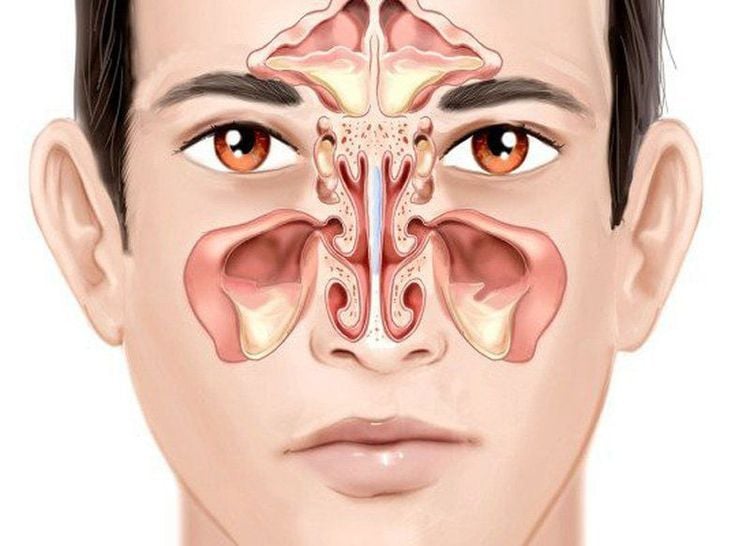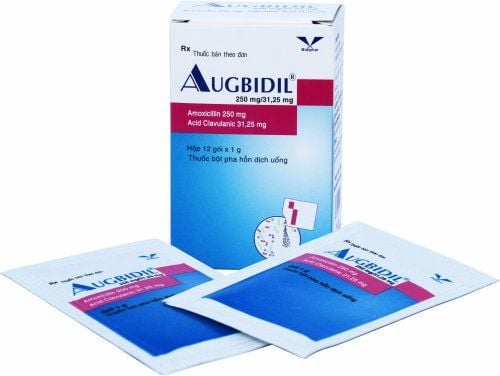This is an automatically translated article.
Sinusitis has two main levels as acute sinusitis and chronic sinusitis. Either way, sinusitis can increase the risk of serious health complications. In this article, readers will be provided with some common sinusitis complications.
1. Find out general information about sinusitis
Sinusitis is a term used to refer to inflammation of the lining of the sinuses inside the nose, causing swelling, edema and congestion of the sinuses. This is an extremely ideal condition for harmful bacteria to grow - develop and create pus in the sinuses. When this amount of pus has no way to escape to the outside, they will accumulate in the sinuses and cause sinus pain.
Patients with sinusitis often have symptoms such as nasal congestion or frequent runny nose, pain in the head and sinuses, areas around the sinuses such as jaw, eyes... Depending on the location, sinusitis is often divided into The types are as follows:
Sinusitis : pain and feeling of heavy pressure in the back of the eye sockets, near the nape of the neck and deep inside the head. Frontal sinusitis: pain in the forehead in the middle and high above the nose and eyes. Maxillary sinusitis: the jaw bone and teeth are painful with headache. Sphenoid sinusitis: also known as ophthalmic sinusitis, occurs when the patient has pain and a feeling of heavy pressure in the eyes and on the top of the head. According to the progression of the disease, sinusitis can be divided into many types, of which the most common are:
Acute sinusitis: usually the disease lasts up to 4 weeks and has severe initial symptoms and sudden, may recur several times per year. Chronic sinusitis : the condition lasts longer than 12 weeks because the patient does not have a timely and proper treatment plan for acute sinusitis, difficult to cure completely and recover like the original.

Biến chứng viêm xoang có thể xảy ra nếu không được điều trị sớm
2. The doctor answered the question, is the complication of sinusitis dangerous?
The answer is yes. According to answers from doctors, sinusitis complications are often serious complications, even life-threatening. In which, some notable complications are respiratory inflammation (including pharyngitis or bronchitis), complications of eye sinusitis, brain complications such as brain abscess, meningitis .. However, not everyone with sinusitis will experience these dangerous complications. According to statistics, patients with sinusitis with immunodeficiency syndrome or other chronic diseases, deviated nasal septum, Staphylococcus infection, Streptococcus ... have a high risk of complications. sinusitis without prompt medical intervention.
3. Summary of dangerous sinusitis complications to note
Complications of sinusitis are divided into different groups depending on the location of sinusitis:
3.1. Complications of Rhinitis Complications from sinusitis in the nose are usually complications related to the health of the respiratory tract, usually less serious, including pharyngitis, acute/chronic bronchitis or laryngitis. ..
3.2. What are the common complications of ocular sinusitis? The type of sphenoid sinusitis (or ocular sinusitis) often causes dangerous complications in the eyes, of which notably:
Orbital inflammation: the orbital part near the sinuses is prone to inflammation in people with sinusitis, symptoms appear Symptoms appear suddenly and are relatively serious, including headache, nasal congestion, eyelid swelling and bulging of the eyeball, severe eye pain... This complication can be treated definitively with medical interventions. . Eyelid Abscess: A pus-filled sac (often called an abscess) will form in the eyelid area, causing the eyelid to become swollen and painful, hot and red. This abscess bag after about 4-5 days will burst, if not handled well, the eyelids are at high risk of infection. Inflammation of the lacrimal sac: Similar to the eyelids, sinusitis can also cause abscess formation and inflammation of the lacrimal sac. Optic neuritis behind the eyeball: Another dangerous complication of ocular sinusitis is inflammation of the optic nerve at the back of the eyeball with specific manifestations of rapid vision loss, although However, patients can regain their vision after a few weeks. In the case of chronic sinusitis, this complication will make the patient's vision always be covered with a mist and make the patient especially sensitive to light, colors cannot be clearly distinguished...

Biến chứng viêm xoang có thể khiến người bệnh mắc một số bệnh lý ở mắt
3.3. Complications of sinusitis in the brain The leading dangerous complication of sinusitis is the complications related to the human brain, especially common are:
Brain infection: when not treated promptly and stopped At the point of sinusitis, the infection will spread to brain cells and surrounding tissues of the brain, causing seizures and serious damage, even causing the patient to die. Meningitis, brain abscess... are other dangerous complications of sinusitis in the brain, causing hearing loss and stroke, which can cause permanent brain damage, even life-threatening. to life. Early recognition signs of sinusitis in the brain include:
Headache and mild fever, often feeling stiff and tense in the neck and nausea. Abnormal mental health, sudden change. One or several parts of the body cannot function. 3.4. Otitis media caused by rhinosinusitis One of the most common complications of rhinosinusitis is problems in the ears, because the nasal cavity and ear have a circulation together, causing pus in the nose can quickly spread to the body. ear. In particular, otitis media is the most common ear complication caused by sinusitis. If not detected and promptly intervened with medical measures, otitis media can make the patient deaf because the pressure of the pus can puncture the eardrum.
3.5. Sinusitis causes bone complications Another dangerous sinusitis complication is osteomyelitis, which can be seen in both acute and chronic sinusitis. Bacteria from the infected area in the sinuses can travel through the bloodstream and spread to many other parts of the body, especially the bones. This condition is very difficult to treat definitively, often requiring prolonged intravenous injection.
4. How to treat sinusitis?
For acute sinusitis, the most common treatment is antibiotic prescriptions lasting 2 to 3 weeks depending on the condition. Some commonly used antibiotics for sinusitis include cefurdate, moxifloxacin, gatifloxacin...
Chronic sinusitis is relatively difficult to treat, requiring a combination of antibiotics with adjuvant measures and surgery. In which, adjuvant treatment of sinusitis is usually the following measures:
Nasal spray with decongestant sprays such as oxymetazoline, pseudoephedrine, guaifenesin... to reduce nasal congestion or runny nose. Regularly rinse your nose with salt water. Corticosteroids will be prescribed when sinusitis is diagnosed as chronic. In addition, the drug is also used with allergic rhinitis and nasal polyps. It can be said that sinusitis complications have many levels, but in general, they all have a serious impact on health. Therefore, when you find yourself suffering from sinusitis, you need to quickly find a definitive treatment as soon as possible.
Vinmec International General Hospital is the address for examination, treatment and prevention of diseases, including the respiratory specialty. When performing the examination process at Vinmec, customers will be welcomed and used modern facilities and equipment along with perfect medical services under the guidance and advice of experts. Good doctors, well-trained both at home and abroad. Therefore, when there is a complication of sinusitis, especially in the eyes, you can go to Vinmec for thorough examination and treatment.
Please dial HOTLINE for more information or register for an appointment HERE. Download MyVinmec app to make appointments faster and to manage your bookings easily.













